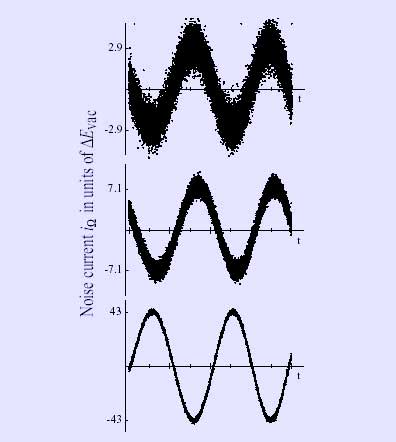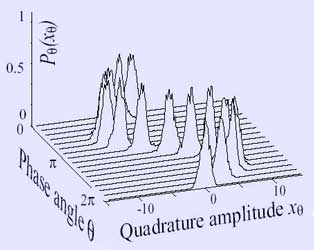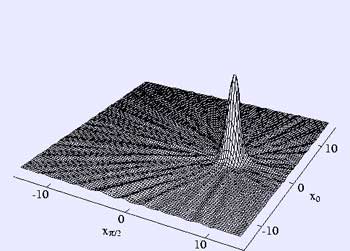In quantum mechanics a coherent state is a specific kind of quantum state of the quantum harmonic oscillator whose dynamics most closely resemble the oscillating behaviour of a classical harmonic oscillator system. It was the first example of quantum dynamics when Erwin Schrödinger derived it in 1926 while searching for solutions of the Schrödinger equation that satisfy the correspondence principle. The quantum harmonic oscillator and hence, the coherent state, arise in the quantum theory of a wide range of physical systems. For instance, a coherent state describes the oscillating motion of the particle in a quadratic potential well. In the quantum theory of light (quantum electrodynamics) and other bosonic quantum field theories they were introduced by the work of Roy J. Glauber in 1963. Here the coherent state of a field describes an oscillating field, the closest quantum state to a classical sinusoidal wave such as a continuous laser wave.
Coherent states in quantum optics

Figure 1: The electric field, measured by optical homodyne detection, as a function of phase for three coherent states emitted by a Nd:YAG laser. The amount of quantum noise in the electric field is completely independent of the phase. As the field strength, i.e. the oscillation amplitude α of the coherent state is increased, the quantum noise or uncertainty is constant at 1/2, and so becomes less and less significant. In the limit of large field the state becomes a good approximation of a noiseless stable classical wave. The average photon numbers of the three states from top to bottom are <n>=4.2, 25.2, 924.5 (source: link 1 and ref. 2)
In quantum mechanics a coherent state is a specific kind of quantum state, applicable to the quantum harmonic oscillator, the electromagetic field, etc. [J.R. Klauser and B. Skagerstam, "Coherent States", World Scientific Publishing Co. Pte. Ltd., Singapore, 1985] that describe a maximal kind of coherence and a classical kind of behavior. Erwin Schrödinger derived it as a mimimum uncertainty Gaussian wavepacket in 1926 while searching for solutions of the Schrödinger equation that satisfy the correspondence principle. It is a minimum uncertainty state, with the single free parameter chosen to make the relative dispersion (standard deviation divided by the mean) equal for position and momentum, each being equally small at high energy. Further, while the expectation value of the Heisenberg equations of motion are zero for all energy eigenstates of the system, in a coherent state the expectation values of the equations of motion are precisely the classical equations of motion, and have small dispersion at high energy. (High energy is guaranteed when mean oscillatory amplitude and momentum have small classical values.) The quantum linear harmonic oscillator and hence, the coherent state, arise in the quantum theory of a wide range of physical systems. They are found in the quantum theory of light (quantum electrodynamics) and other bosonic quantum field theories.
While minimum uncertainty Gaussian wave-packets were well-known, they did not attract much attention until Roy J. Glauber, in 1963, provided a complete quantum-theoretic description of coherence in the electromagnetic field. Glauber was prompted to do this to provide a description of the Hanbury-Brown & Twiss experiment that generated very wide baseline (hundreds or thousands of miles) interference patterns that could be used to determine stellar diameters. This opened the door to a much more comprehensive understanding of coherence. (For more, see Quantum mechanical description.)

Figure 2: The oscillating wave packet corresponding to the second coherent state depicted in Figure 1. At each phase of the light field, the distribution is a Gaussian of constant width.
In classical optics light is thought of as electromagnetic waves radiating from a source. Often, coherent laser light is thought of as light that is emitted by many such sources that are in phase. Actually, the picture of one photon being in-phase with another is not valid in quantum theory. Laser radiation is produced in a resonant cavity where the resonant frequency of the cavity is the same as the frequency associated with the atomic transitions providing energy flow into the field. As energy in the resonant mode builds up, the probability for stimulated emission, in that mode only, increases. That is a positive feedback loop in which the amplitude in the resonant mode increases exponentially until some non-linear effects limit it. As a counter-example, a light bulb radiates light into a continuum of modes, and there is nothing that selects any one mode over the other. The emission process is highly random in space and time (see thermal light). In a laser, however, light is emitted into a resonant mode, and that mode is highly coherent. Thus, laser light is idealized as a coherent state. (Classically we describe such a state by an electric field oscillating as a stable wave. See Fig.1)
The energy eigenstates of the linear harmonic oscillator (e.g., masses on springs, lattice vibrations in a solid, or oscillations in the electromagnetic field) are fixed-number quantum states. The Fock state (e.g. a single photon) is the most particle-like state; it has a fixed number of particles, and phase is indeterminate. A coherent state distributes its quantum-mechanical uncertainty equally between the canonically conjugate coordinates, position and momentum, and the relative uncertainty in phase [defined heuristically] and amplitude are roughly equal -- and small at high amplitude.

Figure 3: Wigner function of the coherent state depicted in Figure 2. The distribution is centered on state's amplitude α and is symmetric around this point. The ripples are due to experimental errors.
Quantum mechanical definition
Mathematically, the coherent state ![]() is defined to be the 'right' eigenstate of the annihilation operator
is defined to be the 'right' eigenstate of the annihilation operator ![]() . Formally, this reads:
. Formally, this reads:
![]()
Since \hat a is not hermitian, α is complex, and can be represented as
![]()
where ![]() is real number. Here
is real number. Here ![]() and
and ![]() are called the amplitude and phase of the state.
are called the amplitude and phase of the state.
Physically, this formula means that a coherent state is left unchanged by the detection (or annihilation) of a particle. The eigenstate of the annihilation operator has a Poissonian number distribution (as shown below). A Poisson distribution is a necessary and sufficient condition that all detections are statistically independent. Compare this to a single-particle state (Fock state): once one particle is detected, there is zero probability of detecting another.
The derivation of this will make use of dimensionless quadratures, X and P. These quadratures are related to the position and momentum of the mass in a spring and mass oscillator:
 ,
,
For an optical field,
 and
and 
are the real and imaginary components of the mode of the electric field.
With these quadratures, the Hamiltonian of either system becomes
![]()
Erwin Schrödinger was searching for the most classical-like states when he first introduced minimum uncertainty Gaussian wave-packets. The quantum state of the harmonic oscillator that minimizes the uncertainty relation with uncertainty equally distributed in both X and P quadratures satisfies the equation
![]() .
.
It is an eigenstate of the operator (P - iX). (If the uncertainty is not balanced between X and P, the state is now called a squeezed coherent state.)
Schrodinger found minimum uncertainty states for the linear harmonic oscillator to be the eigenstates of (X - iP), and using the notation for multi-photon states, Glauber found the state of complete coherence to all orders in the electromagnetic field to be the right eigenstate of the annihilation operator -- formally, in a mathematical sense, the same state. The name "coherent state" took hold after Glauber's work.
The coherent state's location in the complex plane (phase space) is centered at the position and momentum of a classical oscillator of the same phase θ and amplitude (or the same complex electric field value for an electromagnetic wave). As shown in Figure 2, the uncertainty, equally spread in all directions, is represented by a disk with diameter 1/2. As the phase increases the coherent state circles the origin and the disk neither distorts nor spreads. This is the most similar a quantum state can be to a single point in phase space.
Since the uncertainty (and hence measurement noise) stays constant at 1/2 as the amplitude of the oscillation increases, the state behaves more and more like a sinusoidal wave, as shown in Figure 1. And, since the vacuum state ![]() is just the coherent state with α = 0, all coherent states have the same uncertainty as the vacuum. Therefore one can interpret the quantum noise of a coherent state as being due to the vacuum fluctuations.
is just the coherent state with α = 0, all coherent states have the same uncertainty as the vacuum. Therefore one can interpret the quantum noise of a coherent state as being due to the vacuum fluctuations.
(It should be noted that the notation![]() does not refer to a Fock state. For example, at α = 1, one should not mistake
does not refer to a Fock state. For example, at α = 1, one should not mistake ![]() as a single-photon Fock state -- it represents a Poison distribution of fixed number states with a mean photon number of unity.)
as a single-photon Fock state -- it represents a Poison distribution of fixed number states with a mean photon number of unity.)
The formal solution of the eigenvalue equation is the vacuum state displaced to a location α in phase space, i.e., is the displacement operator D(α) operating on the vacuum:
![]()
This can be easily seen, as can virtually all results involving coherent states, using the representation of the coherent state in the basis of Fock states:
 .
.
where |n\rangle are energy (number) eigenvectors of the Hamiltonian. This is a Poissonian distribution. The probability of detecting ~n~ photons is:
![]()
Similarly, the average photon number in a coherent state is ![]() and the variance is
and the variance is ![]() .
.
In the limit of large α these detection statistics are equivalent to that of a classical stable wave for all (large) values of ~\alpha~. These results apply to detection results at a single detector and thus relate to first order coherence (see degree of coherence). However, for measurements correlating detections at multiple detectors, higher-order coherence is involved (e.g., intensity correlations, second order coherence, at two detectors). Glauber's definition of quantum coherence involves nth-order correlation functions (n-th order coherence) for all n. The perfect coherent state has all n-orders of correlation equal to 1 (coherent). It is perfectly coherent to all orders.
Roy J. Glauber's work was prompted by the results of Hanbury-Brown and Twiss that produced long-range (hundreds or thousands of miles) first-order interference patterns through the use intensity fluctuations (lack of second order coherence), with narrow band filters (partial first order coherence) at each detector. (One can imagine, over very short durations, a near-instantaneous interference pattern from the two detectors, due to the narrow band filters, that dances around randomly due to the shifting relative phase difference. With a coincidence counter, the dancing interference pattern would be stronger at times of increased intensity [common to both beams], and that pattern would be stronger than the background noise.) Almost all of optics had been concerned with first order coherence. The Hanbury-Brown and Twiss results prompted Glauber to look at higher order coherence, and he came up with a complete quantum-theoretic description of coherence to all orders in the electromagnetic field (and a quantum-theoretic description of signal-plus-noise). He coined the term "coherent state" and showed that they are produced when a classical electrical current interacts with the electromagnetic field. <<Erroneous reference to "entangled states" removed. Superpostion and entanglement are not the same thing.>>
At ~\alpha \gg 1~, from Figure 5, simple geometry gives \Delta\theta|\alpha|=\frac{1}{2} From this we can see that there is a tradeoff between number uncertainty and phase uncertainty \Delta\theta~\Delta n=1/2, which sometimes can be interpreted as the number-phase uncertainty relation. This is not a formal uncertainty relation: there is no uniquely defined phase operator in quantum mechanics. [See Susskind and Glowgower, Phys. Letters (1963); and Carruthers and Nieto, Rev. Mod. Phys. (1968)]
Mathematical characteristics
The coherent state does not display all the nice mathematical features of a Fock state; for instance two different coherent states are not orthogonal:
![]()
so that if the oscillator is in the quantum state |α> it is also with nonzero probability in the other quantum state |β> (but the farther apart the states are situated in phase space, the lower the probability is). However, since they obey a closure relation, any state can be decomposed on the set of coherent states. They hence form an overcomplete basis in which one can diagonally decompose any state. This is the premise for the Sudarshan-Glauber P representation.
Another difficulty is that a† has no eigenket (and a has no eigenbra). The following formal equality is the closest substitute and turns out to be very useful for technical computations:
a^{\dagger}|\alpha\rangle=\left({\partial\over\partial\alpha}+{\alpha^*\over 2}\right)|\alpha\rangle
The last state is known as Agarwal state denoted as |\alpha,1\rangle. Agarwal states for order n can be expressed as |\alpha,n\rangle=\hat{a}^{\dagger~n}|\alpha\rangle
Coherent states of Bose–Einstein condensates
* A Bose–Einstein condensate (BEC) is a collection of boson atoms that are all in the same quantum state. In a thermodynamic system, the ground state becomes macroscopically occupied below a critical temperature -- roughly when the thermal deBroglie wavelength is longer than the interatomic spacing. Superfluidity in liquid He4 is believed to be associated with the Einstein-Bose condensation in the ideal gas. But, He4 has strong interactions, and the liquid structure factor (a 2nd-order statistic) plays an important role. The use of a coherent state to represent the superfluid component of He4 provided a good estimate of the condensate / non-condensate fractions in superfluidity [F.W. Cummings], consistent with results of slow neutron scattering. Most of the special superfluid properties follow directly from the use of a coherent state to represent the superfluid component -- that acts as a macroscopically occupied single-body state with well-defined amplitude and phase over the entire volume. (The superfluid component of He4 goes from zero at the transition temperature to 100% at absolute zero. But the condensate fraction is less than 20% <<need actual number>> at absolute zero temperature.)
* Early in the study of superfluidity, Penrose and Onsager [Phys. Rev. 104, 576 (1956)] proposed a metric ("order parameter") for superfluidity. It was represented by a macroscopic factored component (a macroscopic eigenvalue) in the first-order reduced density matrix. Later, C.N. Yang [Rev. Mod Phys. 34, 694 (1962)] proposed a more generalized measure of macroscopic quantum coherence, called "Off-Diagonal Long-Range Order" (ODLRO), that included fermion as well as boson systems. ODLRO exists whenever there is a macroscopically large factored component (eigenvalue) in a reduced density matrix of any order. Superfluidity corresponds to a large factored component in the first-order reduced density matrix. (And, all higher order reduced density matrices behaved similarly.) Superconductivity involves a large factored component in the 2nd-order ("Cooper electron-pair") reduced density matrix.
* The orders of reduced density matrices used to describe macroscopic quantum coherence in superfluids are formally the same as the correlation functions used to describe orders of coherence in radiation. Both are examples of macroscopic quantum coherence. The macroscopically large coherent component, plus noise, in the electromagnetic field, as given by Glauber's description of signal-plus-noise, is formally the same as the macroscopically large superfluid component plus normal fluid component in the two-fluid model of superfluidity.
* It should be noted that every-day electromagnetic radiation, such as radio and TV waves, is also an example of near coherent states (macroscopic quantum coherence). (That should "give one pause" regarding the conventional demarcation between quantum and classical.)
Coherent electron states in superconductivity
* Electrons are Fermions, but when they pair up into Cooper pairs they act as bosons, and so can collectively form a coherent state at low temperatures. Such coherent states are part of the explanation of effects such as the Quantum Hall effect in low-temperature superconducting semiconductors.
Generalizations
* In quantum field theory and string theory, a generalization of coherent states to the case of infinitely many degrees of freedom is used to define a vacuum state with a different vacuum expectation value from the original vacuum.
* In one-dimensional many-body quantum systems with fermionic degrees of freedom, low energy excited states can be approximated as coherent states of a bosonic field operator that creates particle-hole excitations. This approach is called bosonization.
See also
* Quantum field theory
* Quantum optics
* Electromagnetic field
* degree of coherence
* quantum coherence
* quantum amplifier
Links
* Quantum states of the light field
* Glauber States: Coherent states of Quantum Harmonic Oscillator
References
* E. Schrödinger, Naturwissenschaften 14 (1926) 664.
* R.J. Glauber, Phys. Rev. 131 (1963) 2766.
* Loudon, Rodney, The Quantum Theory of Light (Oxford University Press, 2000), [ISBN 0-19-850177-3]
* G. Breitenbach, S. Schiller, and J. Mlynek, "Measurement of the quantum states of squeezed light", Nature, 387, 471 (1997)
Retrieved from "http://en.wikipedia.org/"
All text is available under the terms of the GNU Free Documentation License

